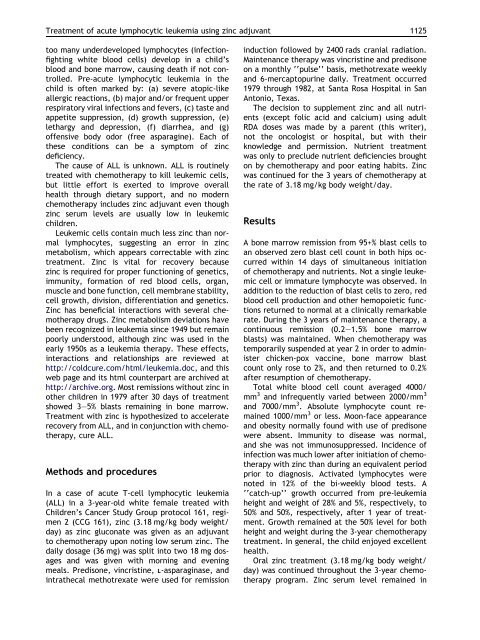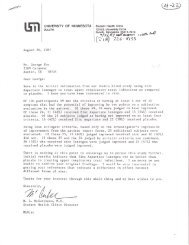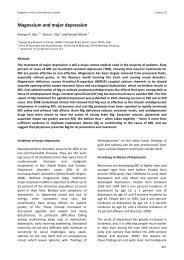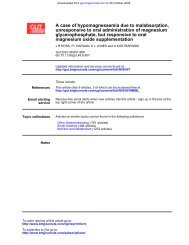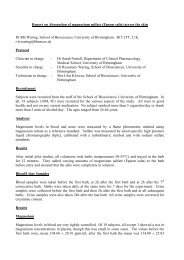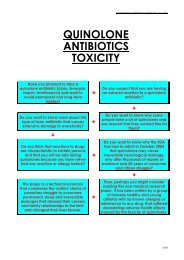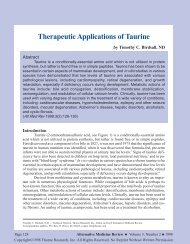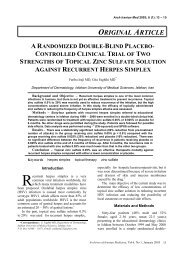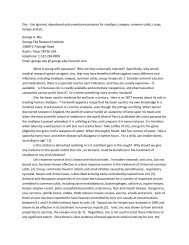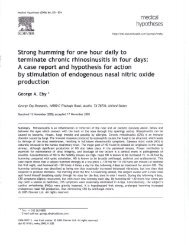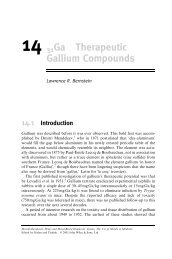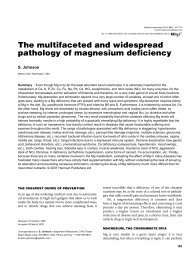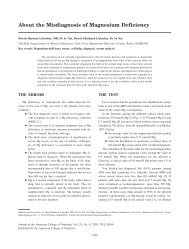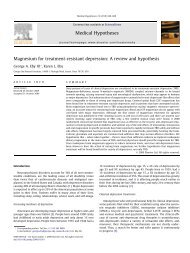Treatment of acute lymphocytic leukemia using zinc adjuvant with ...
Treatment of acute lymphocytic leukemia using zinc adjuvant with ...
Treatment of acute lymphocytic leukemia using zinc adjuvant with ...
Create successful ePaper yourself
Turn your PDF publications into a flip-book with our unique Google optimized e-Paper software.
<strong>Treatment</strong> <strong>of</strong> <strong>acute</strong> <strong>lymphocytic</strong> <strong>leukemia</strong> <strong>using</strong> <strong>zinc</strong> <strong>adjuvant</strong> 1125<br />
too many underdeveloped lymphocytes (infectionfighting<br />
white blood cells) develop in a child’s<br />
blood and bone marrow, ca<strong>using</strong> death if not controlled.<br />
Pre-<strong>acute</strong> <strong>lymphocytic</strong> <strong>leukemia</strong> in the<br />
child is <strong>of</strong>ten marked by: (a) severe atopic-like<br />
allergic reactions, (b) major and/or frequent upper<br />
respiratory viral infections and fevers, (c) taste and<br />
appetite suppression, (d) growth suppression, (e)<br />
lethargy and depression, (f) diarrhea, and (g)<br />
<strong>of</strong>fensive body odor (free asparagine). Each <strong>of</strong><br />
these conditions can be a symptom <strong>of</strong> <strong>zinc</strong><br />
deficiency.<br />
The cause <strong>of</strong> ALL is unknown. ALL is routinely<br />
treated <strong>with</strong> chemotherapy to kill leukemic cells,<br />
but little effort is exerted to improve overall<br />
health through dietary support, and no modern<br />
chemotherapy includes <strong>zinc</strong> <strong>adjuvant</strong> even though<br />
<strong>zinc</strong> serum levels are usually low in leukemic<br />
children.<br />
Leukemic cells contain much less <strong>zinc</strong> than normal<br />
lymphocytes, suggesting an error in <strong>zinc</strong><br />
metabolism, which appears correctable <strong>with</strong> <strong>zinc</strong><br />
treatment. Zinc is vital for recovery because<br />
<strong>zinc</strong> is required for proper functioning <strong>of</strong> genetics,<br />
immunity, formation <strong>of</strong> red blood cells, organ,<br />
muscle and bone function, cell membrane stability,<br />
cell growth, division, differentiation and genetics.<br />
Zinc has beneficial interactions <strong>with</strong> several chemotherapy<br />
drugs. Zinc metabolism deviations have<br />
been recognized in <strong>leukemia</strong> since 1949 but remain<br />
poorly understood, although <strong>zinc</strong> was used in the<br />
early 1950s as a <strong>leukemia</strong> therapy. These effects,<br />
interactions and relationships are reviewed at<br />
http://coldcure.com/html/<strong>leukemia</strong>.doc, and this<br />
web page and its html counterpart are archived at<br />
http://archive.org. Most remissions <strong>with</strong>out <strong>zinc</strong> in<br />
other children in 1979 after 30 days <strong>of</strong> treatment<br />
showed 3–5% blasts remaining in bone marrow.<br />
<strong>Treatment</strong> <strong>with</strong> <strong>zinc</strong> is hypothesized to accelerate<br />
recovery from ALL, and in conjunction <strong>with</strong> chemotherapy,<br />
cure ALL.<br />
Methods and procedures<br />
In a case <strong>of</strong> <strong>acute</strong> T-cell <strong>lymphocytic</strong> <strong>leukemia</strong><br />
(ALL) in a 3-year-old white female treated <strong>with</strong><br />
Children’s Cancer Study Group protocol 161, regimen<br />
2 (CCG 161), <strong>zinc</strong> (3.18 mg/kg body weight/<br />
day) as <strong>zinc</strong> gluconate was given as an <strong>adjuvant</strong><br />
to chemotherapy upon noting low serum <strong>zinc</strong>. The<br />
daily dosage (36 mg) was split into two 18 mg dosages<br />
and was given <strong>with</strong> morning and evening<br />
meals. Predisone, vincristine, L-asparaginase, and<br />
intrathecal methotrexate were used for remission<br />
induction followed by 2400 rads cranial radiation.<br />
Maintenance therapy was vincristine and predisone<br />
on a monthly ‘‘pulse’’ basis, methotrexate weekly<br />
and 6-mercaptopurine daily. <strong>Treatment</strong> occurred<br />
1979 through 1982, at Santa Rosa Hospital in San<br />
Antonio, Texas.<br />
The decision to supplement <strong>zinc</strong> and all nutrients<br />
(except folic acid and calcium) <strong>using</strong> adult<br />
RDA doses was made by a parent (this writer),<br />
not the oncologist or hospital, but <strong>with</strong> their<br />
knowledge and permission. Nutrient treatment<br />
was only to preclude nutrient deficiencies brought<br />
on by chemotherapy and poor eating habits. Zinc<br />
was continued for the 3 years <strong>of</strong> chemotherapy at<br />
the rate <strong>of</strong> 3.18 mg/kg body weight/day.<br />
Results<br />
A bone marrow remission from 95+% blast cells to<br />
an observed zero blast cell count in both hips occurred<br />
<strong>with</strong>in 14 days <strong>of</strong> simultaneous initiation<br />
<strong>of</strong> chemotherapy and nutrients. Not a single leukemic<br />
cell or immature lymphocyte was observed. In<br />
addition to the reduction <strong>of</strong> blast cells to zero, red<br />
blood cell production and other hemopoietic functions<br />
returned to normal at a clinically remarkable<br />
rate. During the 3 years <strong>of</strong> maintenance therapy, a<br />
continuous remission (0.2–1.5% bone marrow<br />
blasts) was maintained. When chemotherapy was<br />
temporarily suspended at year 2 in order to administer<br />
chicken-pox vaccine, bone marrow blast<br />
count only rose to 2%, and then returned to 0.2%<br />
after resumption <strong>of</strong> chemotherapy.<br />
Total white blood cell count averaged 4000/<br />
mm 3 and infrequently varied between 2000/mm 3<br />
and 7000/mm 3 . Absolute lymphocyte count remained<br />
1000/mm 3 or less. Moon-face appearance<br />
and obesity normally found <strong>with</strong> use <strong>of</strong> predisone<br />
were absent. Immunity to disease was normal,<br />
and she was not immunosuppressed. Incidence <strong>of</strong><br />
infection was much lower after initiation <strong>of</strong> chemotherapy<br />
<strong>with</strong> <strong>zinc</strong> than during an equivalent period<br />
prior to diagnosis. Activated lymphocytes were<br />
noted in 12% <strong>of</strong> the bi-weekly blood tests. A<br />
‘‘catch-up’’ growth occurred from pre-<strong>leukemia</strong><br />
height and weight <strong>of</strong> 28% and 5%, respectively, to<br />
50% and 50%, respectively, after 1 year <strong>of</strong> treatment.<br />
Growth remained at the 50% level for both<br />
height and weight during the 3-year chemotherapy<br />
treatment. In general, the child enjoyed excellent<br />
health.<br />
Oral <strong>zinc</strong> treatment (3.18 mg/kg body weight/<br />
day) was continued throughout the 3-year chemotherapy<br />
program. Zinc serum level remained in


